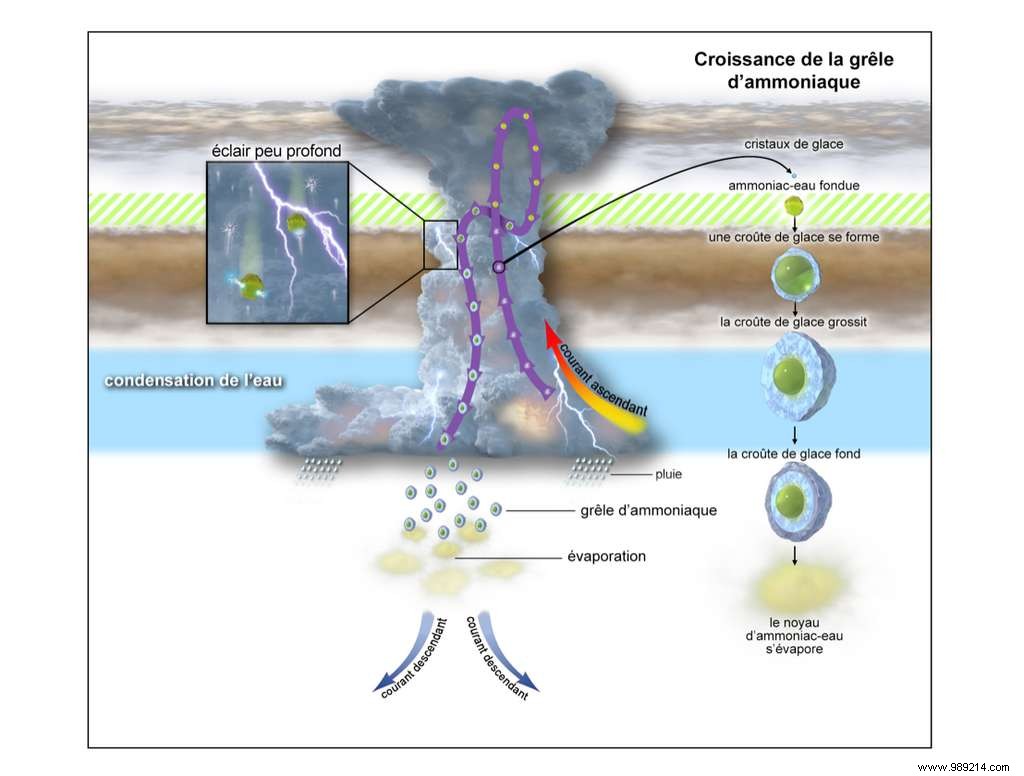The American probe Juno has just revealed to us a new type of lightning in the upper atmosphere of Jupiter. At these altitudes, ammonia hailstones can also form, playing a key role in the atmospheric dynamics of the giant.
Since the passage of the American probe Voyager 1 in the Jovian system in 1979, lightning is regularly spotted in these clouds swirling around Jupiter. Until now, we thought that all were relatively similar to those formed on Earth, produced in clouds where water can be found simultaneously in its solid, liquid and gaseous forms.
On Jupiter, this region is between 45 and 65 km below visible cloud tops. A few weeks ago, however, the American probe Juno spotted a strange phenomenon:the presence of shallow lightning. In other words:formed at much higher altitudes than those usually observed.
If we follow the same rules as on Earth, this lightning should not exist at these Jovian altitudes. Indeed, these flashes have been observed about 25 km higher than Jupiter's water clouds where temperatures dip to around -88°C, which is far too cold for liquid water. strong> . A different mechanism must therefore be at work.
To explain this phenomenon, the researchers suggest that powerful storms at work on Jupiter hurl ice crystals high into its atmosphere where they encounter ammonia vapor. This interaction then melts the ice, creating a cloud of mixed ammonia and water vapour .
“At these altitudes, ammonia acts as an antifreeze, lowering the melting point of water ice to around -100°C and allowing ice to form. 'a cloud with an ammonia-water liquid “, explains Heidi Becker, of the Juno mission. “In this new state, falling ammonia-water droplets can collide with the rising water-ice crystals and electrify the clouds. This is a big surprise, because these ammonia-water clouds do not exist on Earth “.
This mechanism has another side effect:the creation of molten hailstones dubbed "mushballs" by researchers. Roughly, at these heights, an ice crust may form around ammonia droplets. As they become heavier, they then fall like hail and encounter warmer temperatures. These "mushballs" then evaporate back into ammonia and water vapor, and the cycle begins again.

This new discovery made possible by the Juno probe, which is due to leave the Jovian system next year, could also solve another mystery concerning the planet's ammonia. Indeed, the amount of this material seems to change at different points in its atmosphere, and until now, researchers did not know why. The fact that the element is sometimes carried deeper into Jupiter's atmosphere would explain these differences.
“The combination of these two findings was key to solving Jupiter's missing ammonia mystery “, emphasizes Scott Bolton, co-author of this work. “Actually, there is no shortage of it. He is simply transported in disguise, after wrapping himself in a shell of water ice. In this summer, water and ammonia are invisible to us until they reach a certain depth allowing their evaporation “.
An animation of this shallow lightning can be seen in the video below: